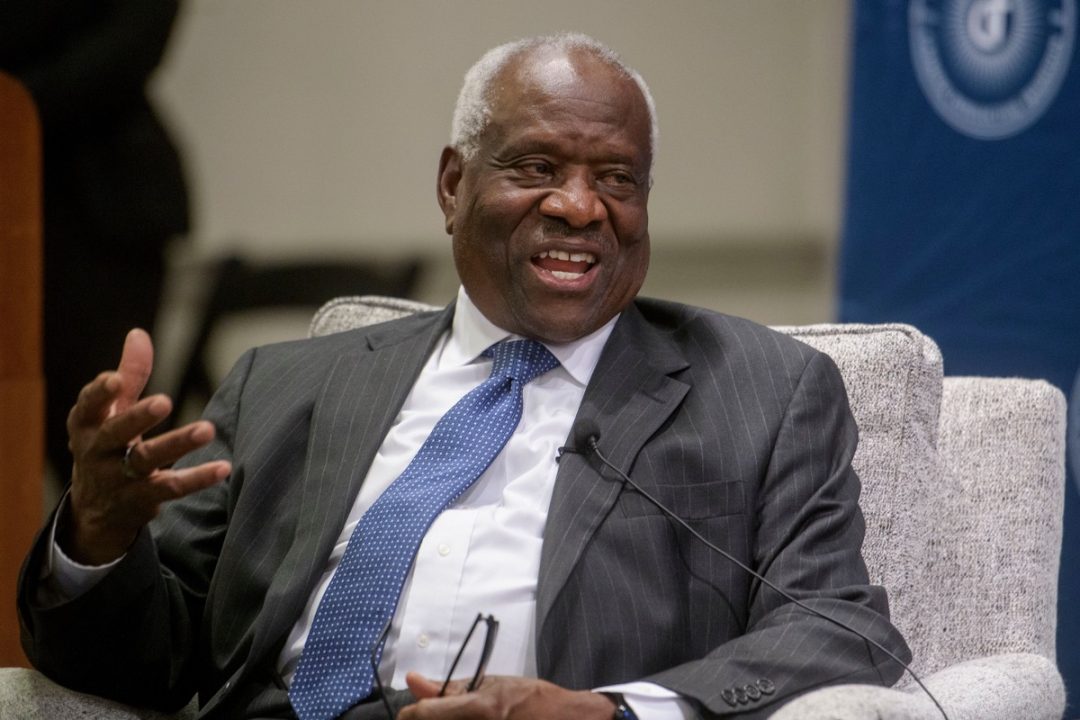
During a September 25 appearance at Catholic University’s Columbus School of Law in Washington, D.C., U.S. Supreme Court Justice Clarence Thomas declared that legal precedents are not “gospel,” challenging the stare decisis overreach that activist judges have used to enforce unconstitutional rulings. Thomas emphasized that flawed precedents must be overturned to restore adherence to the Constitution.
Long-standing Opposition
Thomas’ long-standing criticism of judicial precedent was highlighted in his 2022 concurring opinion in Dobbs v. Jackson Women’s Health Organization, which overturned Roe v. Wade. It challenges precedents such as those set by the Obergefell v. Hodges ruling on same-sex “marriage” and the Humphrey’s Executor v. United States ruling on executive power. Thomas wrote in his concurring opinion in Dobbs that stare decisis should not bind the Court to unconstitutional precedent:
After overruling these demonstrably erroneous decisions, the question would remain whether other constitutional provisions guarantee the myriad rights that our substantive due process cases have generated.
Thomas stressed that precedents must be “respectful of our legal tradition, and our country, and our laws, and be based on something, not just something somebody dreamt up and others went along with.”
The Founders’ Vision
Federal courts have strayed far from the Founding Fathers’ vision of a judicial branch coequal and independent of the legislative and executive branches of government. The Founders designed a system of checks and balances in which Congress and the president could resist unconstitutional court rulings. Article III of the Constitution established the Court’s powers. It granted no interpretive monopoly to the judiciary, and did not bind the other branches to the judiciary’s interpretation.
Thomas Jefferson advocated departmentalism, allowing each branch to interpret the Constitution independently. He warned that an overruling Court would make “the constitution … a mere thing of wax in the hands of the judiciary, which they may twist, and shape into any form they please.”
Historical Opinions
A historical example of this is Andrew Jackson’s presidential veto of legislation passed by Congress to extend the Second Bank of the United States’ charter, defying the Supreme Court’s 1819 McCulloch v. Maryland decision. Jackson declared in his veto message:
If the opinion of the Supreme Court covered the whole ground of this act, it ought not to control the coordinate authorities of this Government. The Congress, the Executive, and the Court must each for itself be guided by its own opinion of the Constitution. Each public officer who takes an oath to support the Constitution swears that he will support it as he understands it, and not as it is understood by others. [Emphasis added.]
Later, Abraham Lincoln ignored the Supreme Court’s Dred Scott v. Sandford ruling when he issued the Emancipation Proclamation.
These executive actions reflect the original understanding that the Court is not supreme, but coequal, not permitted to become an “enemy of the Constitution” through unchecked decisions.
Original Opposition to Judicial Supremacy
The judicial branch’s intended purpose is to interpret laws in individual cases, not dictate binding precedent on the executive and legislative branches. Alexander Hamilton wrote in The Federalist, No. 78:
Whoever attentively considers the different departments of power must perceive, that, in a government in which they are separated from each other, the judiciary, from the nature of its functions, will always be the least dangerous to the political rights of the Constitution; because it will be least in a capacity to annoy or injure them.
James Madison, the Father of the Constitution, shared this view. While supporting judicial review to strike down unconstitutional laws, he opposed supremacy that overrides the other branches. In The Federalist, No. 49, Madison argued that the three branches of government must remain separate and balanced. He said the legislative, executive, and judicial branches are “perfectly co-ordinate” in their authority derived from the people, and none can claim an “exclusive or superior right” to settle boundaries between their powers. He also noted that each independent branch has interpretive authority over the Constitution in performing its duties, and should not defer to judicial supremacy.
Unconstitutional
The concept of “judicial supremacy” — the idea that the Supreme Court is the ultimate arbiter of what is constitutional — is itself unconstitutional, contrary to the intent of the Founding Fathers. By rejecting the concept of judicial supremacy, we follow the Founders’ design and safeguard our Republic from judicial overreach.
Those who oppose departmentalism and originalism ignore how judicial overreach has become an enemy of the Constitution, enabling atrocities such as the 1944 Korematsu v. United States decision that upheld the internment of American citizens of Japanese descent.
Americans must rally behind Thomas’ call to overturn unconstitutional precedents. They must urge Congress to assert its Article III power to limit the jurisdiction of the federal judiciary and restore the Founders’ vision of a constitutional republic with three coequal branches. Furthermore, the states must exercise their sovereign authority and nullify unconstitutional court rulings.




